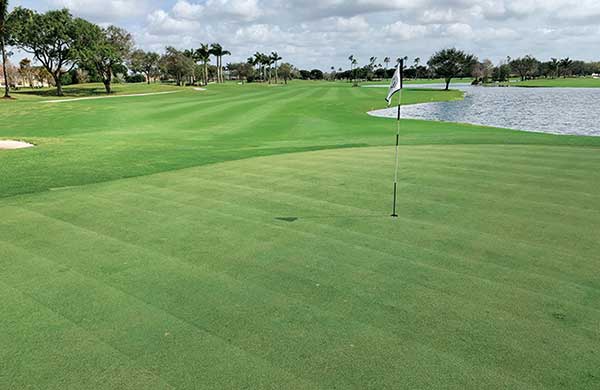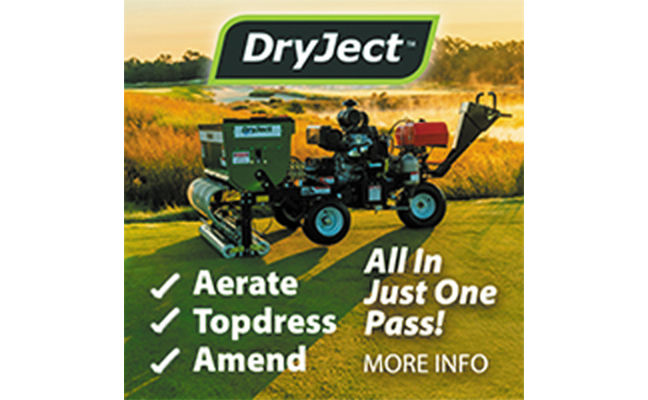Experts’ Insights: Thatch meets its match

Thatch can be controlled by implementing practices such as topdressing, aerification and verticutting. (Photo: Bob Harper)
Topdressing, aerification and verticutting consistently are three keys to controlling thatch, according to Bob Harper, superintendent at Lago Mar Country Club in Plantation, Fla. Harper says his golf course topdresses, on average, about every two to three weeks, verticuts once a month in the growing season and aerifies three times a year.
The course has had Tifeagle ultradwarf bermudagrass on its greens since 2000.
“It’s important to control thatch on ultradwarfs,” Harper says. “In the beginning, it produces a lot of thatch, and we kept verticutting to keep the thatch out, but we realized there was no way to verticut enough to keep thatch at bay, which started to develop on top of greens space.”
Harper notes that the thatch starts to build up in the summer months.
“Even in South Florida, we have a growing season and nongrowing season,” he says. “We verticut in the growing season to account for extra buildup.”
Other than those practices, Harper says it’s important to treat the soil with microbes.
“You can’t mechanically reduce all the thatch; you’re topdressing it, and the thatch buries on itself, so it’s important to have healthy soil microbes,” he says. “We either feed soil microbes with carbohydrates to promote populations or add microbes through certain treatments. It’s consistently included in the spray program.”
Harper also uses growth regulators, such as Primo, anywhere from 1 to 5 ounces per acre as often as weekly in growing season.

Headshot: Marinus Reincke
Maredo BV
Marinus Reincke
CEO
By using coring heads, superintendents can easily reduce their thatch. They can use such coring heads by attaching them to their own triplex greensmower. Superintendents can remove thatch up to 1 inch with 0.25-inch hollows at mowing speed. If the operator goes slower, he or she can achieve more holes per square foot, which can bring the removal percentage up by about 7 percent per pass. Using these types of coring heads helps superintendents ensure that there is a quick healing of the holes and direct playability after using the coring heads.

Headshot: John Paddock
DryJect
John Paddock
Owner
The rate at which thatch accumulates in turf is highly influenced by the inputs of the superintendent. Careful attention should be given to only apply enough fertility and water to produce a uniform and healthy playing surface. Excess inputs will magnify thatch accumulation. Thatch levels can be manipulated by encouraging healthy biological activity (decay) by incorporating either the native soil back into the top portion of the thatch by core aeration and dragging or by topdressing or injection with a blended soil/sand mix or with sand alone. Incorporating both these materials helps to create a “hybrid thatch” or mat. This firms it up and encourages robust microbial activity and decay. Regular incorporation of the desired soil medium will provide the necessary dilution to this organic matter. In sand-based sports turf, the injected or topdressed sand should be close to matching the sand in the soil profile.

Headshot: David Jones
The Club at Indian Springs, Broken Arrow, Okla.
David Jones
Superintendent
We’ve got 36 holes — 18 with bermudagrass greens and 18 with bentgrass greens. The bermudagrass greens get a lot of thatch because they’re constantly growing throughout the summer. On those, we double verticut and topdress every week. We do a big aerification on the bermudagrass in July. On the bentgrass, it’s more spring and fall when they’re growing. In the summertime, the bentgrass greens slow down in our area, and we don’t do a lot of verticutting or topdressing during that time. On the bentgrass greens, we verticut once a month. For aerification on the bentgrass, we do one in the fall and one in the spring. We do a smaller aerification once a month on the bentgrass greens, with smaller tines. We also watch our inputs on fertilization. If you can do a little bit less to keep them from growing, that helps with the thatch.











